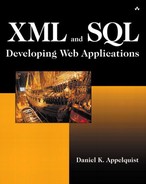Why You Don't Need to Throw Away Your RDBMS
People often come up to me on the street and say, “Tell me, Dan, if I decide to build XML-based systems, what happens to my relational database?” A common misconception is that XML, as a new way of thinking about and representing data, means an end to the relational database management system (RDBMS) as we know it. Well, don't throw away your relational database just yet. XML is a way to format and bring order to data. By mating the power of XML with the immense and already well-understood power of SQL-based relational database systems, you get the best of both worlds. In the following chapters, I'll discuss some approaches to building this bridge between XML and your good old relational database.
Relational databases are great at some things (such as maintaining data integrity and storing highly structured data), while XML is great at other things (for example, formatting data for transmission, representing unstructured data, and ordering data). Using both XML and SQL (Structured Query Language) together enables you to use the best parts of both systems to create robust, data-centric systems. Together, XML and relational databases help you answer the fundamental question of content management and of data-oriented systems in general. That question is “What do I have?” Once you know what you have, you can do anything. If you don't know what you have, you essentially don't have anything. You'llanimtext5 see this question restated throughout thisanimtext5 book in different ways.
